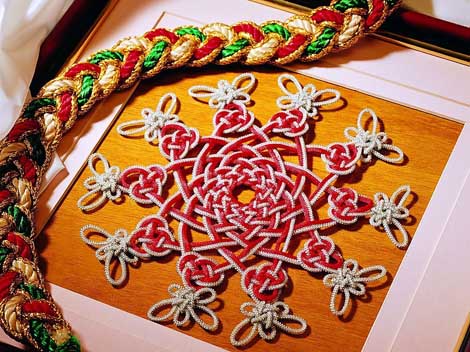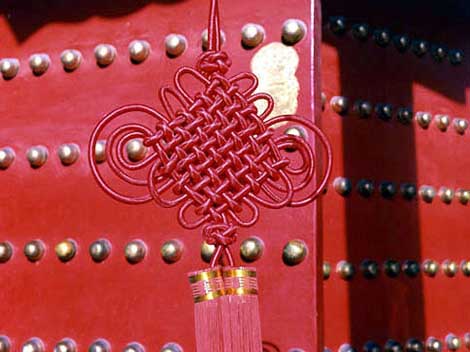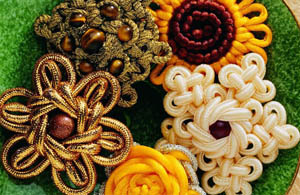

Chinese knots, an embodiment of the craftwork and wisdom of ancient Chinese civilization, are made by winding red cord to express blessings. It is metaphorically used to refer to man's multiplication. Characterized with complicated and varied curves, it can be restored to the simplest line. Originating from a basic tool of primitive society, it is full of graceful appeal. Nowadays people express their blessings in modern ways, sending their regards through phone calls or emails or presenting flowers as gifts. The handmade art of Chinese knots add tea's aroma to the "coffee life" of modern people.
Origin
As far back as remote antiquity, knots, as the predecessor of characters, were used by the Chinese ancestors as a symbol of a contract or historical event. Therefore, it was highly respected by the ancients. However, during the long course of history, diversified materials were used to keep records, such as strings, tortoise shells or animal bones, pen and paper, lead and fire, as well as light and electricity. Now, one is able to obtain information at a simple tap on the keys of a laptop. The tiny knots, no longer used as a tool to keep records, have revived many beautiful age-old legends.
History and Applications
The Chinese knot, also called panchangjie (winding long knot), began in the Tang and Song dynasties as an ornamental art. During the Ming and Qing dynasties, the golden era of handicraft art, people started to name the various knots, endowing them with rich implications. For example, a square knot expressed peacefulness and the ruyi (good-fortune) knot, auspiciousness.
Ancient Times: Dresses and Personal Adornments
With no buttons or zippers, the earliest Chinese dresses were fastened with knots. Taking a panoramic view of the 5,000-year history of Chinese dresses and personal adornments, one marvels at the wide applications of Chinese knots during the dynastic periods, such as colored silk ribbons of the Zhou Dynasty(c. 11th century BC-256 BC), concentric knots of the Northern and Southern Dynasties (420-589), jade-ring ribbons of the Song Dynasty (960-1279), and the wound-knot buttons of the Ming (1368-1644) and Qing (1644-1911) dynasties.
The Painting of Female Officials by Gu Kaizhi, a famous painter of the Eastern Jin Dynasty (317-420), depicted the adornments of the women at that time. For example, simple knots fastened the waistbands of the maids of honor's dresses. In one of the murals in Princess Yongtai's Mausoleum of the Tang Dynasty, the knot on a beauty's waistband is similar to the present bow. Chinese people liked to wear jade ornaments in ancient times, which were tied to their clothes by strings through the circular apertures in the middle.

Cultural Contents
As a long-standing cultural product, the Chinese knot is integrated with the quintessence of the Chinese culture. Ancient poets compared the knot to the varied and colorful human emotions, especially the sentimental love between young men and women. In the Chinese language, the word jie (knot) is connected with many affairs of centrality, like jieyi (to become sworn brothers or sisters), jiemeng (to form an alliance), and tuanjie (to unite). It is used to refer to the important matters like marriage, such as jieqin (to get married), jiefa (to become husband and wife by the first marriage), jiehun (to marry) and jiehe (to be united in wedlock or marriage). Jie also indicates the end or result of something, like jieguo (result or outcome), jieshu (to end or complete), and jieju (final result). Concentric knots have been used by lovers as the tokens of their love since ancient times.
Some Chinese knots are used to ward off evils and disasters, such as panchangjie (winding long knot) and shuangqianjie (double-coin knot), with a strong religious air representing the ancients' cultural beliefs and wishes to pursue the true, the good and the beautiful. The panchangjie on a wedding invitation card implies lifelong love. The ruyi knot on a jade pendant expresses a good wish that one would be successful in everything one undertakes. The falunjie (knot of the wheel of the law) on the handle of a sword implies giving up evils and fostering healthy trends. Chinese knots are also used in some traditional customs to express auspiciousness. For example, on the lunar New Year's Eve, the elders typically give money—100 coins strung on a red silk rope—to each of their children to wish him or her a long life. During the Dragon Boat Festival (5th day of the 5th lunar month), the elders, to ward off evils, hang ropes woven of colorful silk threads, called "long-life threads," around the children's necks.





